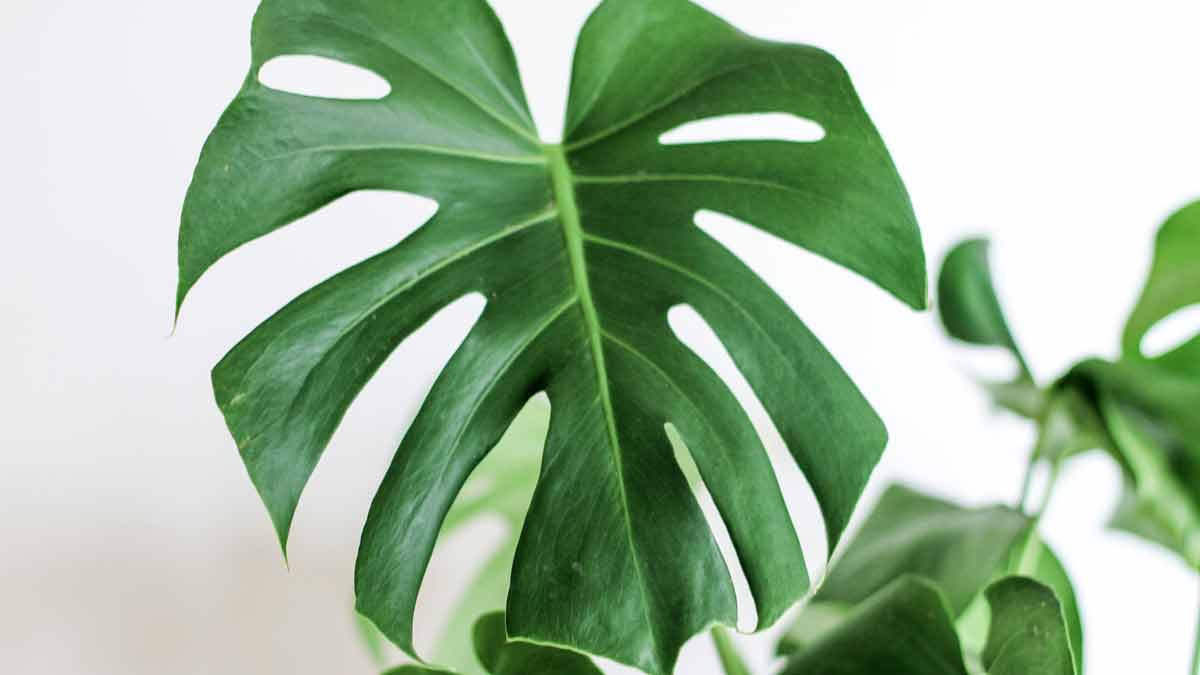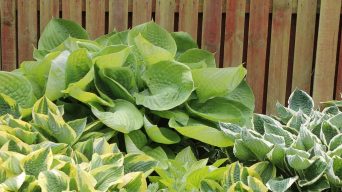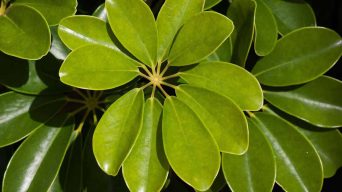To promote bigger leaf growth in your Monstera plant, provide optimal growing conditions, including bright, indirect sunlight (or supplemented with grow lights), well-draining and moist soil, regular watering at the base, and fertilization every two weeks during the growing season. Maintaining a temperature range of 70-85 degrees Fahrenheit and a humid environment can further support leaf development.
Ever dreamt of turning your living room into an urban jungle with wall-sized Monstera plants featuring striking, oversized leaves?
It might not be as monumental a task as you think! Mastering the art and science of nurturing gigantic, healthy foliage in your own Monstera plants can be done right in your home – no greenhouse necessary.
Get ready to unlock the secrets to robust and lush Monstera leaves with our essential plant-care tips that never fail.
Facts and Statistics
- Under ideal conditions, Monstera plants can grow up to 3 feet in a single growing season.
- The largest varieties of Monstera plants, such as Monstera acacoyaguensis, Monstera epipremnoides, and Monstera esqueleto; can produce leaves up to 24 inches long and 12 inches wide.
- A humid environment with a temperature range of 70-85 degrees Fahrenheit is optimal for the growth of Monstera plants, impacting not only the size but also the health of the leaves.
Enhancing Monstera Leaf Growth Outdoors
Growing your Monstera plant outdoors can contribute to larger leaf growth if you’re fortunate enough to have the space and a suitable climate.
The natural elements and conditions found in an outdoor environment provide optimal conditions for a Monstera plant to flourish.
First and foremost, consider the location where you’ll be placing your Monstera.
Choose a spot that receives bright, indirect sunlight for several hours daily.
While Monstera plants love light, direct sunlight can scorch their leaves, so finding a balance is key.
Placing your plant a few feet back from a south-facing window or under a patio with filtered sunlight will help create the ideal lighting conditions.
Next, pay attention to the soil quality and drainage. Use a well-draining soil mix that allows water to pass through easily.
Consider using a combination of coco coir chunks, perlite, and organic mix when repotting your Monstera. Adequate drainage prevents the roots from becoming waterlogged and encourages healthy root development.
Regular watering is important for leaf growth, but be sure not to overwater.
Test the soil moisture by inserting a long wooden skewer or your finger into the soil. If the soil is dry down to at least 2 inches, it’s time to water your plant.
Avoid misting, as it doesn’t effectively increase humidity levels. If you live in a dry climate, you might consider using a humidifier or placing a water tray near the plant to maintain adequate humidity levels.
Another aspect of enhancing leaf growth outdoors is providing structural support for your Monstera. As these plants naturally climb trees in their native rainforest habitats, they benefit from having something to climb on.
You can use moss poles or trellises to help guide their growth upwards, leading to bigger and more robust leaves.
For instance, Tyler had a small Monstera plant that he decided to move outdoors to a covered porch during the summer months.
With the combination of natural light, fresh air, and a moss pole for support, his Monstera plant experienced vigorous growth over the season.
It boasted larger leaves with intricate splits and fenestrations, making it an eye-catching addition to his outdoor space.
Remember, growing your Monstera outdoors requires regular monitoring and care.
Keep an eye out for pests such as thrips or mites and address any issues promptly. Also, protect extreme weather conditions like heavy rain or frost.
You can enhance leaf growth when growing Monstera plants outdoors by providing adequate sunlight, well-draining soil, appropriate watering techniques, and structural support.
Role of Sunlight in Leaf Size
Sunlight plays a crucial role in the size and development of Monstera leaves. These plants are native to tropical rainforests, where they receive dappled sunlight through the dense canopy above.
Replicating similar lighting conditions indoors is challenging, but understanding how sunlight influences leaf size can help optimize their growth.
Monstera plants require bright, indirect sunlight to thrive.
When exposed to sufficient light, the photosynthesis process occurs efficiently, prompting healthy leaf production. Insufficient light can result in stunted growth and smaller leaves.
Take Lisa’s experience as an example. She initially placed her Monstera plant in a corner of her living room away from any windows because she believed it would be low-maintenance there.
However, over time, she noticed that her plant’s leaves were pale green and considerably smaller than other Monstera plants she had seen.
After relocating the plant to a spot near a window where it received bright indirect sunlight for several hours each day, she observed significant improvement – larger leaves with vibrant green coloration and distinct fenestrations.
It’s important to note that while sunlight is essential, direct sunlight can harm Monstera leaves. Exposing them to direct sun for extended periods can lead to leaf burn and damage. Finding the right balance of bright indirect sunlight is crucial.
Think of it like providing the perfect amount of nourishment for your body – too little and you’ll become weak, too much, and your body will suffer from adverse effects. The same principle applies to Monstera plants and their exposure to sunlight.
Impact of Climates on Leaf Enlargement
The climate in which a Monstera plant is grown plays a significant role in determining the size and growth rate of its leaves.
Different climates provide varying conditions that can either enhance or hinder leaf enlargement. Let’s explore these impacts further:
In tropical and humid climates, Monstera plants thrive due to the favorable conditions they naturally prefer.
The warm temperatures, high humidity levels, and consistent rainfall contribute to optimal growth and larger leaves.
The combination of heat and moisture helps create the ideal environment for Monstera plants to flourish, resulting in faster growth and the development of robust foliage.
On the other hand, colder climates can present challenges for Monstera leaf enlargement.
In regions with colder temperatures, Monstera plants may grow slower, and their leaves may not reach their full potential size.
Cold temperatures can impede the plant’s metabolic processes, affecting overall growth and hindering leaf expansion.
Additionally, low humidity levels commonly associated with cold climates can dry out the air, making it more challenging for Monstera plants to thrive.
However, it’s important to note that while climate can impact leaf enlargement, it’s possible to cultivate healthy Monstera plants with larger leaves even in less ideal climates with proper care and adjustments to environmental conditions.
Creating suitable indoor conditions and providing appropriate care can influence Monstera leaf growth regardless of external climate factors.
Influencing Monstera Leaf Growth Indoors
When growing Monstera plants indoors, there are several factors you can control to promote leaf enlargement and create an environment conducive to optimal growth.
By paying attention to these critical aspects of indoor care, you can influence your Monstera’s leaf size:
Light Exposure:
Monstera plants thrive in bright but indirect light.
Position your plant a few feet back from a south-facing window to ensure it receives ample light without being directly exposed to harsh rays.
Insufficient light can result in slow growth and small leaves, so it’s important to provide adequate lighting conditions.
Temperature and Humidity:
Maintaining a comfortable temperature range of 70-85 degrees Fahrenheit is optimal for Monstera leaf growth.
Furthermore, Monstera plants thrive in conditions with high humidity, ideally ranging between 60% to 70%.
You can increase humidity by using a humidifier or placing the plant on a pebble tray filled with water to create a more humid microclimate around the plant.
Watering and Fertilization:
Consistent and proper watering practices are essential for encouraging leaf enlargement in Monstera plants.
Water your plant once a week or when the top few inches of soil have dried out.
Avoid overwatering, as it can lead to root rot and other issues.
Regular fertilization every two weeks during the growing season with a balanced houseplant fertilizer will provide essential nutrients for healthy leaf development.
Soil Type:
Choosing the right soil mix is crucial for optimal growth.
A well-draining mixture that retains some moisture without becoming waterlogged is ideal.
Consider using a mix of coco coir chunks, perlite, and organic soil for good drainage and root health.
You can significantly influence Monstera leaf growth indoors by implementing these care tips and creating an environment mimicking the plant’s natural habitat.
With consistent care and attention to these factors, you’ll be on your way to cultivating lush Monstera foliage with impressive leaf sizes.
Perfecting Indoor Conditions for Larger Leaves
Creating the perfect indoor environment for your Monstera plant is crucial if you want to maximize leaf size and growth.
While these stunning plants are adaptable, they thrive when specific conditions are met. Let’s explore some essential tips to perfecting indoor conditions for larger leaves.
First and foremost, Monstera plants love bright, indirect sunlight.
Placing your Monstera a few feet away from a south-facing window can provide the ideal amount of light.
However, be cautious not to expose it to direct sunlight, which can scorch the leaves.
If natural light is limited in your space, you can supplement with grow lights designed for indoor plants. Ensure the light source is positioned at the appropriate distance to avoid burning the foliage.
Maintaining proper humidity levels is another essential factor in promoting larger leaf growth.
Monstera plants typically prefer higher humidity, so consider using a humidifier or employing other methods such as placing a tray of water near the plant or grouping it with other houseplants.
Misting the leaves may seem intuitive to raise humidity levels; however, it isn’t very effective and might lead to water droplets sitting on the foliage, potentially causing fungal issues.
Another option is to create a pebble tray by filling a shallow dish with water and placing pebbles in it.
Rest your potted Monstera on top of the pebbles, ensuring the water level is below them. As the water evaporates, it increases humidity around the plant.
Temperature also plays a role in Monstera leaf growth. The optimal temperature range for these plants is between 70-85 degrees Fahrenheit (21-29 degrees Celsius).
Avoid exposing your Monstera to extreme temperature fluctuations or drafts to ensure consistent growth and healthy leaves.
Besides environmental factors, providing well-draining and moist soil is essential for optimum leaf growth. Use high-quality potting soil designed for aroids, and make sure your pot has adequate drainage holes to prevent waterlogging, which can lead to root rot.
As mentioned earlier, maintaining appropriate humidity will also contribute to the well-being of the roots and overall plant health.
Remember, each Monstera plant is unique, and its growth rate may vary.
Be patient and observe your plant closely to determine if any adjustments are needed regarding light exposure, humidity, temperature, or watering routine.
The goal is to create a stable and consistent environment that mimics their natural habitat, encouraging larger leaf development.
Techniques for Boosting Leaf Growth
Now that we’ve created an ideal indoor environment for our Monstera plant let’s explore techniques that can specifically boost leaf growth.
While healthy overall conditions are essential, some additional care practices can further enhance the growth and size of Monstera leaves.
One effective method is fertilization. During the growing season (spring and summer), it’s beneficial to provide regular fertilization every two weeks using a balanced liquid houseplant fertilizer diluted according to the package instructions. This helps provide the necessary nutrients for robust leaf development.
Remember to reduce or suspend fertilization during the dormant phase in winter, as Monstera plants require less nutrition during this period.
Another technique is assisting your Monstera in climbing or producing aerial roots. By providing a moss pole or other support structure near your plant, you encourage upward growth, which can result in larger leaves.
Gently tie the stems to the support using plant-safe ties like twine or soft fabric strips. This mimicry of their natural environment stimulates aerial roots development, supporting new foliage growth.
Pruning strategically is another technique worth considering.
By selectively pruning certain stems or branches, you can redirect energy towards specific growth areas, including larger leaves.
Be cautious not to remove too much foliage at once, as this can stress the plant. Instead, opt for light pruning by trimming back leggy growth or cutting just above a node where new growth will emerge. This helps create a bushier appearance and encourages new leaf development.
Pruning Strategy for Leaf Maximization
Pruning is a crucial aspect of growing bigger Monstera leaves.
By strategically trimming certain parts of the plant, you can redirect energy towards the development and growth of larger leaves.
Let’s explore some effective pruning strategies that can help maximize leaf size.
One important step in the pruning process is to remove any damaged or diseased leaves. These leaves may not contribute to your Monstera’s overall health and growth, so it’s best to trim them off.
Additionally, removing dead or yellowing leaves allows the plant to focus its resources on producing new, healthy foliage.
Another pruning technique is topping or pinching. This involves cutting off the top portion of the main stem or vine.
Doing so encourages lateral growth and branching, leading to more leaves and a bushier appearance. This technique promotes increased leaf production, ultimately contributing to the possibility of larger leaves.
In addition to strategic pruning, feeding your Monstera appropriately plays a vital role in encouraging the growth of giant leaves.
Feeding Your Monstera for Giant Leaves
To develop those coveted giant Monstera leaves, providing your plant with appropriate nutrients is essential.
Ensuring appropriate fertilization is crucial to provide your plant with the essential elements it needs for ideal growth. Keep the following suggestions in mind when nourishing your Monstera to promote the development of large leaves.s.
First and foremost, choose a fertilizer specifically formulated for houseplants or tropical foliage plants.
Look for formulations with balanced macronutrients, such as N-P-K ratios close to 10-10-10 or 20-20-20. These balanced nutrients provide a well-rounded diet for your Monstera.
Once you have selected a suitable fertilizer, it’s important to follow the recommended dosage instructions carefully.
Over-fertilizing can lead to salt build-up in the soil, causing damage to the roots and slowing down growth. It’s better to err on the side of caution and slightly under-fertilize than risk overdoing it.
Think of fertilizing your Monstera like providing a balanced diet for yourself. Just as you need a variety of nutrients for overall health, your Monstera needs a well-balanced fertilizer for optimal leaf growth.
Another factor to consider when feeding your Monstera is the timing and frequency of fertilization.
During the growing season, it’s recommended to fertilize your Monstera every two weeks. This regular feeding provides a continuous supply of nutrients to support leaf development. In contrast, during the winter months or when growth slows down, you can reduce the frequency and fertilize once a month.
Some gardeners find success by using organic fertilizers or plant-based solutions like compost tea. These options can be effective in providing slow-release nutrients while also improving soil health.
However, it’s important to note that organic fertilizers may have lower nutrient concentrations, so you may need to adjust your application rates accordingly.
Remember to always water your Monstera first before applying fertilizer. This helps prevent any potential burn or damage to the roots from concentrated fertilizer solutions.
Additionally, ensure that the fertilizer is evenly distributed around the plant’s root zone.
Choosing The Right Fertilizer and Soil Mix
When it comes to growing bigger Monstera leaves, choosing the right fertilizer and soil mix is essential for providing your plants with the necessary nutrients and a suitable growing environment.
Let’s delve into some key considerations to help you make the best choices.
Firstly, let’s talk about fertilizers. Monstera plants are known to be voracious feeders, requiring regular nourishment to support their growth.
Opting for a balanced, water-soluble fertilizer with a ratio of nitrogen (N), phosphorus (P), and potassium (K) like 20-20-20 or 10-10-10 can provide a good foundation for your plants.
However, it’s crucial not to over-fertilize, as excessive amounts can harm the plant and cause burn damage to the roots. Follow the instructions on the fertilizer packaging carefully, diluting it to the appropriate strength before application.
Applying fertilizer once every two weeks during the growing season – typically spring and summer – will suffice to promote healthy leaf development.
Let’s say you have a Monstera plant that has been thriving in your living room. It’s lush and green, but its leaves aren’t as big as you’d like them to be.
You start using a balanced water-soluble fertilizer every two weeks during spring and summer. Over time, you’ll gradually notice an increase in leaf size until they reach their potential.
Turning our attention to the soil mix, Monstera plants prefer well-draining soil that retains moisture without becoming soggy.
A suitable mix can include components such as peat moss or coco coir for water retention, perlite for drainage, and organic matter like compost or aged bark fines for added nutrients.
In summary:
| Components | Purpose |
|---|---|
| Peat Moss/Coco Coir | Retains moisture for the plant’s hydration |
| Perlite | Promotes drainage to prevent waterlogging |
| Organic Matter | Provides nutrients and supports healthy root growth |
When repotting your Monstera or preparing a soil mix, ensure you balance these components well. Aim for a ratio that allows water to move freely without saturating the roots while providing enough moisture for the plant.
Some may argue that adding sand to the soil mix can aid in preventing gnats or balancing soil pH levels.
While this may work for certain plants, it’s important to note that sand can also impede drainage in Monstera plants if not mixed properly. It’s best to prioritize well-draining components like perlite instead.
Think of your Monstera’s soil mix as a well-designed recipe. Just like a chef balances flavors and textures, your soil mix should achieve the right balance between water retention and drainage. Too much of one ingredient can throw off the entire dish!
In conclusion, choosing the right fertilizer and soil mix is crucial for growing bigger Monstera leaves. Opt for a balanced, water-soluble fertilizer and follow the instructions carefully to avoid over-fertilization.
When it comes to the soil mix, aim for a blend of peat moss or coco coir, perlite, and organic matter to ensure proper drainage and nutrient retention.
By providing your Monstera with the right nourishment and growing environment, you’ll create optimal conditions for those impressive, lush leaves to flourish.
Final Thoughts
Growing Monstera plants with bigger leaves is a rewarding journey that blends science and art.
Whether you’re tending to your Monstera indoors or embracing the great outdoors, the key to success lies in mimicking its natural habitat.
Sunlight, temperature, humidity, and well-draining soil all play crucial roles in promoting impressive leaf growth. Just as a chef perfects their recipe, you can fine-tune your plant-care regimen to achieve the ideal balance.
From strategic pruning to proper fertilization, the techniques we’ve explored in this guide are your secret ingredients.
So, go ahead and unlock the secrets to lush Monstera foliage with our tips that never fail.
With patience and dedication, your living space can truly transform into an urban jungle graced by those iconic, oversized Monstera leaves. Remember to care for your Monstera leaves, and they’ll thrive like never before.







